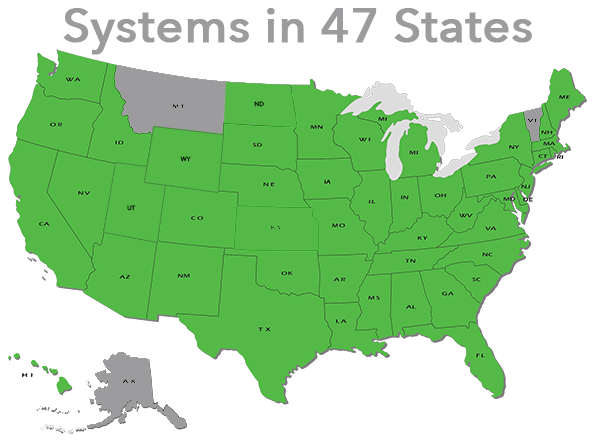What is the role of coal in the United States?
Last Updated: June 2, 2014
The United States holds the world's largest estimated recoverable reserves of coal and is a net exporter of coal. In 2013, U.S. coal mines produced just under one billion short tons of coal, the lowest output level since 1993. More than 90% of this coal was used by U.S. power plants to generate electricity. While coal has been the largest source of electricity generation in the United States for over 60 years, its annual share of total net generation declined from nearly 50% in 2007 to 39% in 2013 as some power producers switched to more competitively priced natural gas. At the same time, new environmental regulations also made it more costly to operate some coal plants.
Coal is an abundant U.S. resource
The United States is home to the largest estimated recoverable reserves of coal in the world. In fact, we have enough estimated recoverable reserves of coal to last more than 200 years, based on current production levels. Coal is produced in 25 states spread across three major coal-producing regions. In 2013, approximately 70% of production originated in five states: Wyoming, West Virginia, Kentucky, Pennsylvania, and Illinois.
Most U.S. coal is used to generate electricity
About 93% of the coal consumed in the United States is used for generating electricity. The United States has around 1,300 coal-fired electricity generating units in operation at almost 560 plants across the country. Together, these power plants consumed more than 858 million short tons of coal to generate 39% of the electricity produced in the United States during 2013.
Although coal-fired generation still holds the largest share among all sources of electricity, its use has declined since 2007 due to a combination of slow growth in electricity demand, strong price competition with natural gas, increased use of renewable technologies, and new environmental regulations. See related article—Today in Energy, July 6, 2012.
While the share of total net electricity generated from coal in the United States is expected to decrease by 2040, coal is still expected to remain an important fuel in generating electricity in the United States in the absence of policies designed to reduce emissions of carbon dioxide and other greenhouse gases. However, the implementation of new policies to limit carbon dioxide emissions from power generation could significantly change the outlook for the use of coal in generating electricity.
Besides its role in generating electricity, coal also has industrial applications such as in cement production and coke conversion for the smelting of iron ore at blast furnaces used to make steel. A small amount of coal is also burned to heat commercial, military, and institutional facilities, and an even smaller amount is used to heat homes.
The United States exports coal to other countries
Between 2000 and 2012, about 5% of the coal produced in the United States, on average, was exported to other countries. In 2013, the share of U.S. coal production that was exported increased to 12%, totaling 117.7 million short tons. However, the overall volume of coal exports declined by 6% from 125.7 million short tons in 2012.
Europe and Asia continue to be the top destinations for U.S. coal exports. Coal exports come in two forms:
Metallurgical coal, which can be used for steel production Steam coal, which can be used for electricity generation and in industrial applications for the production of steam and direct heat.The United States exported more metallurgical coal than steam coal in 2013, Brazil was the largest importer of U.S. metallurgical coal and the United Kingdom was the largest importer of U.S. steam coal.
The United States also imports a small amount of coal, with most of it coming from Colombia. Some coal electric generating units along the Gulf Coast and the Atlantic Coast find it cheaper to import coal from other nations than to have domestic coal transported by rail or barge from the coal-producing regions of the United States.
Coal is a relatively inexpensive fuel
Although some natural gas plants are more efficient than coal plants at generating electricity, in the past the fuel cost of generating one kilowatthour of electricity from natural gas had typically been higher than that of coal. However, coal began losing its price advantage over natural gas for electricity generation in some parts of the country in 2009, particularly in the eastern United States. A surge in natural gas production from U.S. shale deposits substantially reduced the price of natural gas, thus making it more competitive for use in generating electricity. See related article—Today in Energy, May 23, 2013.
Environmental effects from using coal
The mining of coal can have a negative impact on ecosystems and water quality. When coal is burned it produces several types of emissions that adversely affect the environment and human health. Coal emits sulfur dioxide, nitrogen oxide, heavy metals (such as mercury and arsenic), and acid gases (such as hydrogen chloride), which have been linked to acid rain, smog, and other environmental and health-related concerns. Coal also emits carbon dioxide, the greenhouse gas most responsible for global warming. In 2013, coal accounted for 32% of the energy-related carbon dioxide emissions in the United States.
Outlook for future coal use
The economics of burning coal may change if the United States adopts policies that restrict or otherwise control carbon dioxide (CO2) emissions.
In January 2014, the U.S. Environmental Protection Agency (EPA) issued a revised new source performance standard proposal for emissions of CO2 that requires new coal-fired power plants to limit their emissions to 1,100 pounds of CO2 per megawatthour. The proposed emission limit would effectively require that new coal-fired electric generating units employ carbon capture and sequestration (CCS) technologies to reduce uncontrolled emissions of CO2 by approximately 50%.
For existing power plants, in June 2014 the EPA released proposed rules designed to cut CO2 emissions at current coal-fired electric generating units 30% from 2005 levels by the year 2030.
CCS would theoretically address much of coal's carbon dioxide emissions. However, substantial economic and technological hurdles for CCS remain.
In March 2013, the EPA finalized the Mercury and Air Toxics Standards to reduce emissions of mercury and other air toxics from new and existing coal and oil-fired electric generating units. Power plants are responsible for more mercury emissions than any other man-made source. See related article—Today in Energy, March 28, 2014. The standards were challenged in court, but they were upheld by a federal appeals court in April 2014.
Separately, recent further efforts to control nitrogen oxide (NOx) and sulfur dioxide (SO2) emissions from power plants could also have an effect on the use of coal in electricity generation. The EPA's Cross-State Air Pollution Rule (CSAPR), finalized in July 2011, seeks to reduce SO2 and NOx emissions from power plants in 28 states. The rule was challenged, but in April 2014 the U.S. Supreme Court upheld CSAPR.


























